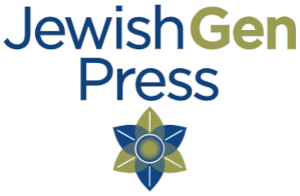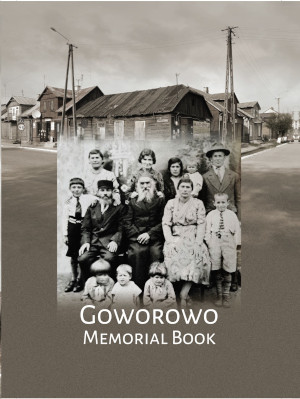

(Goworowo, Poland)
Translation of
Goworowo; sefer zikaron
Published by the JewishGen Press
Original Yizkor Book Edited By: Aviezer Burstin and Dov Kossovsky
Available from
for $40.00
Project Coordinator: Lester Blum
Emeritus Coordinator: Martin Jacobs
Cover Design: Nina Schwartz
Layout, formatting and indexing: Jonathan Wind
Book Summary: Bruce Drake
8.5”x11” Hardcover, 524 pages with original photographs
 |
Details:
Goworowo was a small village in east central Poland about 50 miles northeast of Warsaw. The earliest known Jewish community dates to the 18th century. 1,228 Jewish residents lived there in 1921 out of a total population of 5,299.
The book contains detailed articles about life in Goworowo primarily during the interwar years and the Nazi invasion of September 1939. The town is meticulously described in a chapter titled “A Walk in the Shtetl” which profiles individual townspeople and their occupations, providing a wealth of names. “A Chapter of History” captures the history and culture of the town.
Goworowo was considered a business town and had a greater economic base than neighboring shtetlekh of the same size. The middle class consisted of merchants and craftsmen who provided the surrounding Christian villages with merchandise. Goworowo's cobblers, tailors, and hatters exhibited their wares in fairs in distant towns. There was also a class of wealthier Jews who managed larger businesses like mills, warehouses, construction companies and trade in manufactured and agricultural products.
Other chapters are devoted to Goworowo's religious life, community organizations and institutions, political movements, scholars, leaders and other personalities who are the subject of more than 50 profiles. A lighter side of life in the shtetl includes accounts of its pranksters and its folklore.
In the first World War the shtetl suffered greatly from the retreating Russian army which was being driven out of Poland by German and the Austro-Hungarian armies. The Russians accused the Jews of the Shtetl of espionage and burnt down the town in 1915 forcing them to flee to neighboring towns. After the occupation by the German army, some of the Jews who had fled Goworowo returned and began to rebuild the ruins. But new troubles started when Jews found themselves to be the target of hostile decrees and persecutions as Poland regained its independence following the war.
The Holocaust section of the book covers mainly the early period of German occupation after Hitler declared war on Poland in September 1939. People who lived through it describe the sense of dread that built as the Germans were reported to get closer and closer, preceded by waves of refugees from other towns. The killing began with the shooting of 70 people and the burning of the whole town. There is a long “List of the Slain” gathering the names of those who lost their lives under the German occupation.
Goworowo [Pol], Govorova [Yid], Govorovo [Rus], Govorove
Goworowo, Poland is located at 52°54' N 21°34' E 51 miles NNE of Warszawa
|
 JewishGen Press
JewishGen Press
 JewishGen Home Page
JewishGen Home Page
Copyright © 1999-2025 by JewishGen, Inc.
Updated 15 Jul 2025 by LA